
* In the 1950s, the Soviet Union developed a turboprop-powered strategic bomber, the "Tu-95", named the "Bear" by NATO, which was produced in good numbers and in a range of variants. It became a prominent symbol of Soviet power and remains in service. This document provides a history and description of the Tu-95 series, including the "Tu-142" antisubmarine warfare variants, the "Tu-114" airliner, and the "Tu-126" airborne early warning platform derived from the Tu-114.
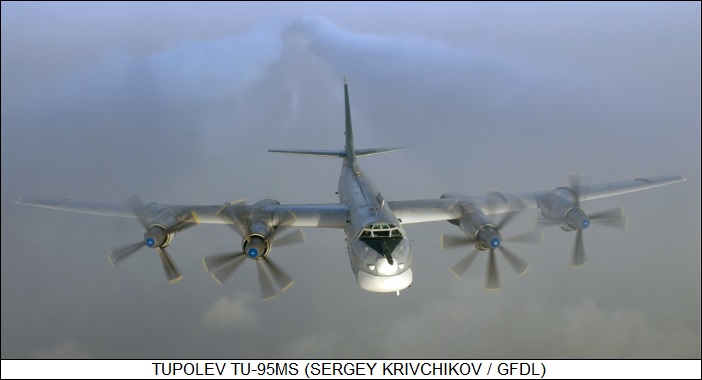
* During World War II, the Soviet Red Air Force was organized as a tactical air arm, focused on battlefield support; the only strategic bombing assets possessed by the service were a handful of Petlyakov Pe-8 four-engine bombers, roughly comparable to the British Short Stirling.
By the end of the conflict, the Americans had developed and used the atomic bomb; Soviet dictator Josef Stalin had been kept up-to-date on the development program through Red spies in the US, and was determined to push the construction of a Soviet atom bomb to keep pace with the Americans. Of course, an atomic bomb was of limited use without the means of delivering it, and so Stalin also pushed for the development of a long-range bomber. In 1944, two Soviet OKBs (experimental design bureaus), those run by Vladimir Myasishchev and Andrei Tupolev, were ordered to generate preliminary designs for such a bomber. They used the advanced US Boeing B-29 Superfortress as a starting point.
Work on the new designs proved troublesome, however, and so the decision was made for the Tupolev OKB to reverse-engineer the B-29 itself -- three of them having landed in Siberia after being damaged in raids against Japan -- and put it into production. Initial flight of the B-29 copy, designated the "Tu-4", was in 1947, with NATO assigning the type the reporting name "Bull". Hundreds of them were built up to 1953. With the detonation of the first Soviet atomic bomb in 1949, the Soviet Union had the nuclear option, and with the Tu-4 the means to deliver it.
* The problem was that there was no way to deliver Soviet nuclear weapons to the continental United States, the range being extreme for a Tu-4 even assuming a one-way trip -- which was considered as an option, the crew supposedly to ditch at sea after a strike and be recovered by submarine. Other work was done to give the Tu-4 an inflight refueling capability, though only a few were ever fitted with inflight refueling kit.
Obviously, the Soviet Union needed a bomber with much longer range, and both the Myasishchev and Tupolev OKBs were tasked with development of such a machine. The Myasishchev OKB came up with the turbojet-powered "M-4", which was assigned the NATO reporting name of "Bison"; it was not highly successful, in particular falling far short on the vital range specification, was only built in modest quantity, and is discussed elsewhere.
The Tupolev OKB work is of interest here. Various options were considered by the Tupolev OKB, the most obvious being simply to improve the Tu-4. The result was construction of a prototype of the "Tu-80", which still looked much like a B-29, except notably for a stepped cockpit; it also featured a stretched wing and fuselage, with increased fuel tankage giving it about a third more range than the Tu-4. That wasn't good enough, and the Tu-80 program was canceled months before the initial flight of the prototype on 1 December 1949. The prototype was retained for trials work.
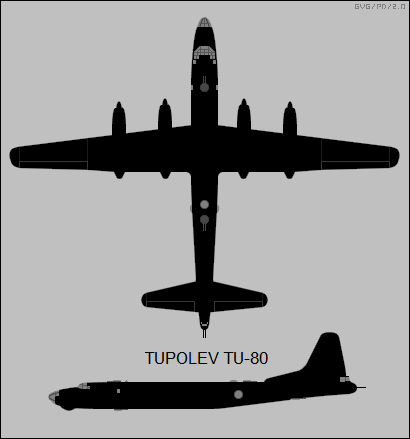
Focus had shifted to a further improved machine, the "Tu-85", which was superficially similar to the Tu-80 -- but still larger, in particular with a substantially enlarged wing, and with about twice the range of the Tu-4. Initial flight of the first of two prototypes was on 9 January 1951. It seemed to be all that was expected of a long-range bomber, and series production was approved. However, the authorities then took note of the losses suffered by American B-29s over North Korea against modern Mikoyan MiG-15 jet fighters. The conclusion was that a souped-up B-29 simply could not survive against well-prepared air defenses, and so the Tu-85 was canceled in turn.
* Obviously something more radical was required. The Tupolev OKB had already been considering such an advanced design, essentially a Tu-85 with swept wings and either turbojet or turboprop propulsion. On detail analysis, turboprops won out, with the new aircraft, the "Tu-95", to be powered by four powerful Kuznetsov TV-2 turboprops driving contra-rotating propellers. The TV-2 was based on a German design, the Junkers 109-022, that never reached production, with German designers working for the Soviets on the project. In maturity, this engine would become the most powerful turboprop built in the 20th century.
Initial flight of the first Tu-95 prototype was on 12 November 1952, powered by preliminary TV-2F engines. Unfortunately, on 11 May 1953, the prototype crashed, with four crew killed but seven managing to bail out. An early investigation suggested that one of the engines had fallen off due to defective manufacture of the aircraft. In Stalin's USSR, serious failures were labeled treason, and the punishment for treason was death; so two engineers responsible for building the aircraft were sentenced to be shot.
However, further study indicated that one of the turboprops had a problem with the reduction gear that led to a fire -- given the sheer power of the engine, building reduction gear that could handle the load was troublesome, and there had been such failures in tests. The lives of the two engineers were spared, but it is said that when Kuznetsov heard the news that the reduction gear was the actual cause of the crash, he fainted.
Fortunately for him, other officials involved with the development program appealed to the authorities, pointing to Kuznetsov's many demonstrable services to the state, and so he wasn't shot either. Although sorting out the specifics of Stalin's terror is very difficult to sort out in hindsight -- one reason being that it could be monstrous to the point of very hard to believe -- it appears such death sentences were often commuted if the condemned was clearly valuable to the Soviet state, worth more alive than dead. Kuznetsov was put on a very short leash to prove he could deliver a properly working engine. No doubt his motivation level to deliver was very high.
A second prototype took to the air on 16 February 1955. The Tu-95 had already been approved for production by that time and a factory in Kuibyshev was working on an initial production batch, with the first two production machines rolled out in August. The Tu-95 was displayed to the world in a fly-over at the annual Tushino airshow near Moscow that year, with Western observers finding it extremely interesting -- rightly suspecting that the USSR had finally obtained a strategic bomber with true intercontinental range. Whether anyone suspected its B-29 ancestry is an interesting question.
The fact that the Tu-95 used propeller propulsion seemed backwards, few being aware of the aircraft's high performance, it being one of the fastest prop-powered aircraft to reach full operational service. NATO assigned it the reporting name of "Bear" -- which, given how much a symbol of Soviet power the Tu-95 would become, was an extremely apt choice.
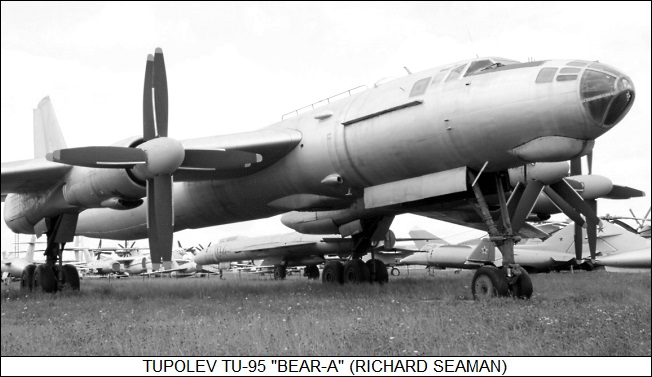
Only a handful of initial-production Tu-95 machines was built, production quickly moving on to the slightly improved "Tu-95M", and all the Tu-95s upgraded to Tu-95M standard. The type entered formal operational service in 1957. Once later variants of the Tu-95 were introduced, NATO modified the reporting name of the Tu-95/95M to "Bear-A".
BACK_TO_TOP* The Tu-95M was of all-metal construction, made mostly of aircraft aluminum alloy with some use of magnesium parts. The aircraft featured mid-mounted swept wings with four turboprop engines; a swept tail assembly; and tricycle landing gear. There was a pressurized compartment forward and rear, separated by the bomb bay and a rear unpressurized equipment section.
Leading-edge sweep of the wing was 37 degrees out to the outer engine nacelle, then decreasing to 35 degrees, while the tail surfaces all had a leading-edge sweep of 40 degrees. There were flaps inboard and three-section ailerons outboard on each wing. The initial production Tu-95 was fitted with NK-12 turboprops -- "NK-12" being the production designation for the TV-2 -- providing a staggering 8,950 kW (12,000 EHP) each, with the Tu-95M featuring the NK-12M engine, providing the same power ratings but with technical improvements. Each engine drove a contra-rotating propeller with four blades on each prop stage; the blades were fully reversible, highly effective at reducing landing roll. Each engine nacelle featured a fire extinguisher system and firewalls.
___________________________________________________________________
TUPOLEV TU-95M "BEAR-A":
___________________________________________________________________
wingspan:
50.4 meters (165 feet 4 inches)
wing area:
283.7 sq_meters (3,053 sq_feet )
length:
46.17 meters (151 feet 5 inches)
height:
13.3 meters (43 feet 8 inches)
empty weight:
76,500 kilograms (168,600 pounds)
MTO weight:
165,155 kilograms (364,000 pounds)
max speed at altitude:
910 KPH (565 MPH / 490 KT)
service ceiling:
11,900 meters (39,030 feet)
range:
13,120 kilometers (8,150 MI / 7,090 NMI)
___________________________________________________________________
The two-wheel steerable nose gear retracted backward, while the four-wheel main gear -- organized in 2x2 bogey arrangement -- retracted backward into the inner engine nacelles, flipping over during retraction. There was a bumper under the tail to protect the aircraft from tail strikes on takeoff. Electrical deicing was used for flight surfaces, props, and windscreen, though the engine inlets used hot-air deicing.
All offensive stores were carried internally in the two-section bomb bay. A typical warload was 5 tonnes (5.5 tons), though the maximum warload was 20 tonnes (22 tons). Along with nuclear stores, the Tu-95M could carry combinations of conventional bombs, with the smallest stores carried being 250-kilogram (550-pound) bombs -- 45 such bombs could be hauled, typically for an airfield attack mission. Bomb-aiming was by a radar targeting system with a backup optical sight. The Tu-95M was optimized for the nuclear strike mission, and so the bomb bay featured heating and climate control, nuclear stores demanding a bit of babying. The cockpit glazing, incidentally, featured blast visors to protect the crew from nuclear flash.
There were three defensive gun positions, in the form of a remote-controlled barbette above and below the rear fuselage, plus a manned tail position. The dorsal barbette was retractable; the two barbettes were directed by three gunners, one in a dome behind the cockpit, one each in a blister window on each side of the rear fuselage under the tailplane. All three gun positions were armed with twin AM-23 23-millimeter automatic cannon, with the overall ammunition store being 2,500 rounds.
Avionics included radios, radio navigation aids, identification friend or foe (IFF) transponder, and a Rubidy-MM bombing-navigation radar mentioned above in a fairing under the nose, which was glazed for use by the navigators. A film camera was fitted under the fuselage, primarily for bomb damage assessment. The crew compartments were heated and ventilated, though not air-conditioned. There were ten crew, with the cockpit crew including:
The tail-section crew consisted of three gunners. The cockpit crew got into the aircraft through a hatch in the nose gear bay, while the tail crew got in through a hatch below the tail. The aircraft was fitted with a number of emergency exits, with one of the cockpit exits featuring a slide to keep the crew from taking a nasty fall. There were two inflatable life rafts for ditching at sea.
It appears that the Tu-95 was generally liked by aircrew and ground crew, at least once the bugs were worked out; one early problem was that the prop feathering system was manually activated, which made it clumsy to use, leading to a fatal landing accident at the outset of the Bear's service. An automated prop feathering system was quickly developed in consequence. In cold weather, oil tended to freeze up in the engines while the aircraft was sitting on the runway, requiring troublesome procedures to keep the oil liquid; eventually the problem was solved by coming up with a low-temperature oil blend.
In maturity, the Tu-95 handled well, was very sturdy, and relatively straightforward to maintain; it would have an enviably low accident rate. There were misgivings over the lack of ejection seats, and the associated dangerous inconvenience of bailing out of the aircraft; given its large size, taxiing it on the runway could be troublesome. It might seem that the turboprop propulsion resulted in high noise levels and crew fatigue, but if so, sources don't mention it. The Bear in its various guises would become very familiar to Western naval forces as the big aircraft prowled the oceans.
* The Tu-95M was followed by a modestly-improved version, the "Tu-95MA", the major change being a tweak to the engine nacelles. In the 1980s, the survivors of the first-generation Tu-95 machines were converted into "Tu-95U" trainers by removing the weapon systems and sealing the bomb bay shut; these machines could be recognized by a red stripe forward of the tail assembly.
There were a number of "one-off" variations on these early machines, including:
Work was conducted in parallel with Tu-95 development on a high-altitude derivative, the "Tu-96", to be powered by advanced TV-16 turboprop engines. A prototype was built, using NK-12s, to be re-engined with TV-16s when they became available. The decision was then made that, in the face of improved Western air defenses, altitude no longer provided much protection; the Tu-96 was never fitted with TV-16s, and served out its life as a trials machine.
BACK_TO_TOP* The primary Soviet strategy for dealing with stronger air defenses was to move towards stand-off missiles that would allow a bomber to destroy a target from a relatively safe distance away. There had been interest from early on in using the Bear as a stand-off missile carrier, with work from 1955 on modifying a Tu-95M to carry the Kh-20 (NATO AS-3 Kangaroo) missile, with the modified aircraft performing its first flight at the beginning of 1956. The missile / missile carrier "complex" was designated "Kometa-20" or just "K-20", and so the revised bomber was designated the "Tu-95K".
The Kh-20 was a big liquid-fueled rocket vehicle, carried semi-externally under the fuselage and extended out into the airstream for launch. For trials, two piloted Mikoyan MiG-19 fighters were modified for carriage by the Tu-95K, the air-launched fighters being designated "SM-20". Incidentally, there were also schemes in which a special piloted ramjet nuclear strike aircraft would be carried by a Tu-95, with the ramjet vehicle dropped outside the target area to make a fast dash to the target -- but that concept never reached the implementation stage.
A Tu-95M was modified as the prototype of the Tu-95K, performing its first flight in its new form at the beginning of 1956. The revised bomber featured a modified nose, with the front glazing eliminated and a prominent fairing wrapped around the bottom of the nose for the Yad radar (NATO Crown Drum) used to direct the Kh-20 missile -- the bomber had to track the target in order to guide the missile into it. The Tu-95K was accepted into service in 1960; once it became known to NATO, it was assigned the reporting name of "Bear-B".
The Kh-20 missile was "draggy" of course, and cut into the bomber's range. The solution was midair refueling. Initially, the idea was to implement the "wingtip to wingtip" refueling scheme used on the Tupolev Tu-16 bomber; that didn't work out, so the Tu-95K was instead fitted with a nose probe for hose and drogue refueling from Myasishchev M-3 "Bison" tankers. The result was known as the "Tu-95KD", with "D" standing for "Dalniy" or "Range". A total of from 70 to 80 Tu-95K/KD machines was built, with most of the Tu-95Ks updated to Tu-95KD specification. In the 1970s, a few Tu-95Ks that weren't updated were converted to a trainer configuration, the "Tu-95KU", along the lines of the Tu-95U.
Incidentally, since the Tu-95K/KD was kitted up to carry the Kh-20 missile under the belly, the bomber couldn't carry free-fall bombs, and so a special centerline external container was developed that could be used to haul such munitions. Details are unclear; the container never reached operational use.
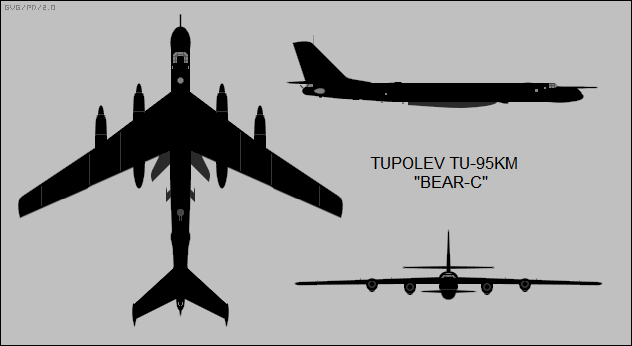
* During the 1960s, many Tu-95KD machines were upgraded with new avionics, being given the revised designation of "Tu-95KM", with the "M" effectively standing for "Modernized". The Tu-95KM looked exactly like Tu-95KD except for a teardrop fairing one each side of the rear fuselage for the SRS-6 Rhomb-4A electronic surveillance measures (ESM) system, used to locate targets from their radio and radar emissions. The Kh-20 missile was also upgraded to the improved "Kh-20M" specification. NATO assigned the Tu-95KM the reporting name of "Bear-C".
* The Kh-20 missile was subsonic, and so it was clearly behind the times by the late 1960s. Work had been going on since early in the decade on a much more potent stand-off weapon, the Kh-22, a much more capable supersonic missile that NATO would designate "AS-4 Kitchen". Work was initiated on developing an appropriate carrier version of the Tu-95, which would emerge as the "Tu-95K-22".
A Tu-95KM was modified as a prototype. The revised aircraft looked much like the Tu-95KM, but featured updated targeting and avionics systems, with the tail guns deleted and replaced by ECM gear. The Tu-95K-22 could actually carry three Kh-22 missiles, one in the belly as with the Kh-20, plus one under each inner wing on a pylon -- though it appears three missiles was an unusual fit. Initial flight of the prototype was in 1975, though trials proved time-consuming, the first Kh-22 launch only occurring in 1981 and the type not reaching operational service until 1987. The Tu-95K-22 fleet consisted of both new-build aircraft and upgrades from Tu-95KM machines. NATO gave the variant the reporting name of "Bear-G".
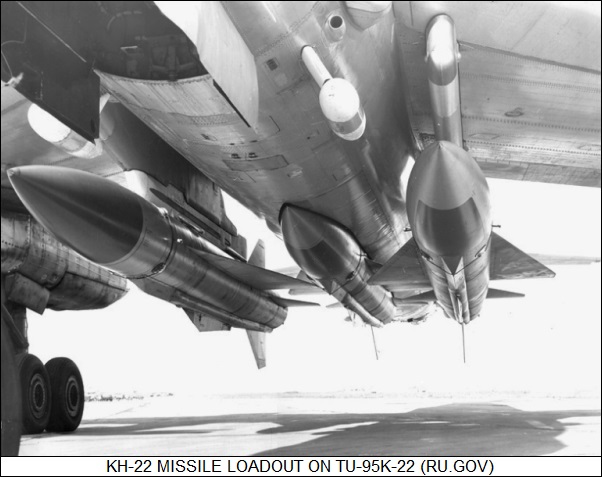
Some Bear-Gs were fitted with an air sampling pod outboard under each wing to collect radioactive fallout from the atmosphere as a secondary mission. Some Tu-95K-22 machines were also kitted up to carry three external bomb containers for conventional attack, the warload being 45 250-kilogram (550-pound) bombs, the primary mission being airfield attack.
In addition, there was work on modifying a Tu-95M to carry the KSR-6 stand-off missile, which was essentially a scaled-down derivative of the Kh-22, generally carried by the Tupolev Tu-16 "Badger" bomber. Initial flight of the modified Tu-95M was in 1976, but then the decision was made that there was no compelling reason to use the Tu-95 as a KSR-6 launch platform.
BACK_TO_TOP* The Soviets were very fond of anti-ship missiles, seeing them as an equalizer against Western naval power. Along with air-launched anti-ship missiles, anti-ship missiles were also carried by Soviet submarines and surface warfare vessels. In the late 1950s, work began on an advanced anti-ship missile for submarine or surface vessel launch, which emerged as the P-6 (NATO SS-N-3). It was a sophisticated weapon, but it had one significant limitation: it had to be guided by a remote platform all the way to the target, and so submarines and surface vessels could not use the P-6 to perform "over the horizon" attacks.
The Tu-95, with its long endurance, seemed well-suited for performing maritime surveillance and then, once it had spotted targets, directing P-6 missiles against them. Work began on an appropriate version of the aircraft in 1959, with the new variant designated "Tu-95RTs" -- where "RTs" could be loosely interpreted as "reconnaissance / targeting system". Incidentally, that was the system designation, the aircraft variant by itself being referred to as the "Tu-95RC".
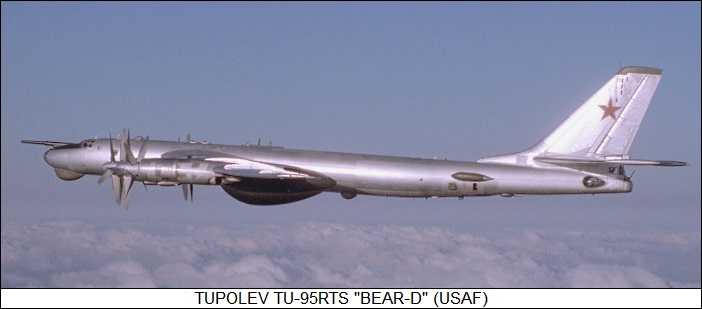
A Tu-95M was modified as the prototype, the primary changes being:
Initial flight of the aircraft in its new form was in September 1963. Getting all the electronics gear working right proved troublesome, however, and the system was not declared operational until 1966. Production aircraft featured Rhomb-4 ESM gear, with the teardrop fairings on the rear fuselage as per the Tu-95KM. By the time of formal service introduction, a force of Tu-95RT machines was available to the AVMF, the Red Navy air arm, the Kuibyshev factory having begun to roll out production aircraft in late 1963.
Once NATO became aware of the Tu-95RTs, it was given the reporting name "Bear-D". It became a common sight for Western naval forces as it prowled the oceans in search of potential targets. If it came to a shooting match, a submarine or surface vessel launch platform would fire a salvo of three or four P-6 missiles at targets identified by a Tu-95RTs; the aircraft would simply keep the targets illuminated by radar, with the radar imagery passed back to operators on the launch platform, who would adjust the course of the missiles by relaying the course corrections back through the Tu-95RTs.
* Roughly in parallel with the development of the Tu-95RTs, the Soviets worked on a strategic reconnaissance variant of the Tu-95. The effort focused on a minimum-change derivative of the Tu-95M, with an extensive camera suite in the bomb bay and addition of electronic intelligence (ELINT) gear. Four "Tu-95RM" machines were built as conversions of Tu-95M machines, with the first flying it its new form in 1961. Three of the four were fitted with inflight refueling probes.

The Tu-95RM remains one of the most obscure Bear variants, partly due to the small numbers built, partly due to its nondescript appearance -- it looked pretty much like a stock Bear-A, except for additions such as the nose probe and ESM fairings like those of the Bear-C along the rear fuselage, along with camera ports in the bomb bay and a few additional small antenna fairings under the forward fuselage. NATO assigned the Tu-95RM the reporting name of "Bear-E"; these machines served into the 1980s, to then be converted into Tu-95U trainers.
BACK_TO_TOP* In 1963, work began at the Tupolev OKB on a derivative of the Tu-95 for the long-range antisubmarine warfare (ASW) role, to be operated by the AVMF. The naval variant, to be designated "Tu-142", was based on the Tu-95RTs, but of course the avionics suite was considerably updated, with the new system built around the "Berkut (Golden Eagle)" search radar developed for the Ilyushin Il-38 sub-hunter. The first of three prototypes performed its initial flight on 18 July 1968, followed by the second in September. Aircraft were available for operational evaluation in 1970, with the Tu-142 going into service with the AVMF in 1972.
NATO assigned it the reporting name of "Bear-F". Incidentally, Westerners were confused enough about the identity of other Bear variants to tag the Tu-95RTs Bear-D and Tu-95RM Bear-E as Tu-142 variants, presumably because they were assigned maritime roles.
The combat system for the Tu-142 was elaborate, with the Berkut radar complemented by an ELINT system, an infrared detection system, and a sonobuoy receiver system. A bomb bay was retained, positioned behind the radar fairing, to carry sonobuoys, homing torpedoes, depth charges, or mines. There were substantial changes to the airframe:
Not too surprisingly, once introduced into service, the complicated Tu-142 demonstrated shortcomings. Handling left something to be desired and the avionics suite was unreliable. Handling problems were mostly due to excessive weight; the rough-field requirement, which was never very realistic to begin with, was abandoned and so after early production, the heavy twelve-wheel main gear was replaced with four-wheel units similar to those of the Tu-95, but reinforced -- developed for the Tu-114 airliner, discussed later. The extended inboard engine fairings and larger flaps were abandoned. It is hard to find photos of a Tu-142 with the 12-wheel main gear, and possibly at least some of the early production machines were updated to the four-wheel gear in service.
The avionics problems were partly addressed by deleting the infrared scanner, which had proven ineffective, and simplifying the ECM system. This variant also included bunks for the crew so they could get some rest on long patrols. No new reporting name was specified -- though NATO designated the updated machines as "Bear-F Mod 1", since they were visibly different from early production machines.
Although initially Tu-142 production was at the Kuibyshev factory, the plan was over the longer run to switch it to State Factory Number 60 in Taganrog in southwestern Russia. Initial production at Taganrog was of the "Tu-142M", which was much like the late production baseline Tu-142 with a few slight changes at most. NATO was apparently able to tell the difference, designating it "Bear-F Mod 2".
* In operational service, the Tu-142's combat system did not prove highly effective in ASW operations, leading to a reconsideration of the combat avionics suite. The main improvement was an "explosive sonobuoy system", in which sonobuoys were dropped followed by an explosive charge, with a processing system on the aircraft sorting out the echoes to pinpoint a sub's location.
Along with the new sonobuoy scheme, the avionics suite was generally upgraded to a much more sophisticated configuration, designated the "Korshun-K" -- "Korshun" meaning "kite", as in a small hawk -- with a magnetic anomaly detector (MAD) mounted somewhat unconventionally on the rear of the tip of the tailfin; a side-looking radar system; a much-improved search radar; and advanced processing / control systems. The MAD system would not prove very effective due to its positioning, the Bear's airframe causing interference with the sensor.
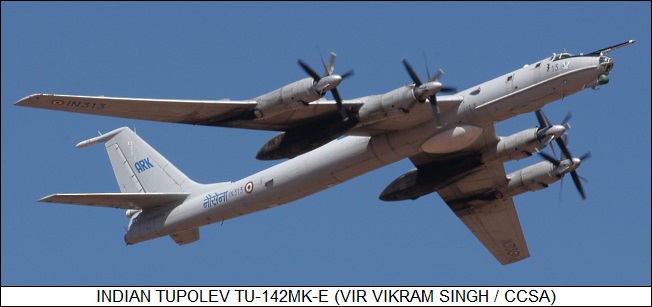
Although an initial prototype was flown in 1975, working out the bugs proved time-consuming and the "Tu-142MK" didn't enter service until 1979. NATO assigned it the reporting name of "Bear-F Mod 3". India obtained eight such machines with slightly downgraded avionics in the 1980s, these aircraft being designated "Tu-142ME"; these were the only Bears to be exported, with Indian crews giving them the name "Albatross", for its graceful flight. They were later refurbished and updated by the Russian Beriev organization, the first machine being redelivered in 2011. They were retired in 2017, having been replaced by the Boeing P-8I Poseidon maritime patrol aircraft.
A handful of Tu-142MK machines was built as submarine communications relay aircraft, reeling out a long trailing antenna from a rig under the belly to transmit and receive low-frequency signals that could penetrate through water. These machines, designated "Tu-142MR", a distinctive thimble nose radome in place of the nose glazing and a fairing like that of the MAD system on the tailfin, but mounted forward instead of to the rear. NATO gave them the reporting name of "Bear-J". Incidentally, NATO never assigned a "Bear-I" reporting name; NATO didn't use the "I" suffix because it was too easily confused with "1".
* The Tu-142MK was followed in turn in the late 1980s by the "Tu-142MZ", which not only provided an improved Korshun-KN-N combat avionics suite, but still more powerful and fuel-efficient NK-12MA engines, rated at 11,185 kW (15,000 EHP). The NK-12MA also featured heftier electric generators to support onboard systems. NATO dutifully assigned the reporting name of "Bear-F Mod 4", of course.
The Tu-142MK featured a distinctive "pimple" antenna fairing on the front of the nose glazing, as well as a new tail turret, derived from that developed for the Tu-22M "Backfire" bomber, with twin two-barreled GSh-23 cannon, meaning the turret bristled with four barrels. While a tail turret was a bit antiquated by that time -- an interceptor could stand off and destroy the bomber with a long-range missile -- the Soviets developed 23-millimeter chaff and flare rounds, allowing the tail turret to be used as a countermeasures system in itself. The observation blisters on each side of the tail were deleted.
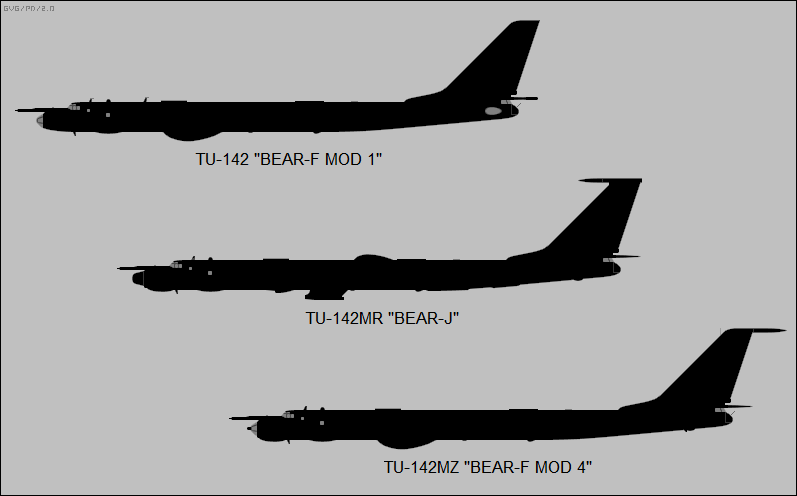
The Tu-142 was an extremely capable ASW platform, with long range, good warload, and highly sophisticated combat avionics. It spent much of the Cold War seeding the "Greenland-Iceland-UK Gap" with sonobuoys to try to spot US Navy hunter-killer submarines that could be a threat to Red Navy missile submarines, with USAF F-15 Eagles operating from Iceland keeping an eye on the Tupolevs. The Tu-142s also operated out of Cuba, with the Americans keeping a close eye on them, and from Angola.
Due to its complexity, the Tu-142 was relatively expensive to operate and difficult to maintain, and so the burden of Soviet long-range ASW duties fell on the Ilyushin Il-38, even though it only had about half the range. A few Tu-142 machines were used for engine and other trials, in some cases being designated "Tu-142LL". After the fall of the USSR, there was some talk of converting excess Tu-142 machines as long-range commercial cargo aircraft, though it seems little came of the idea. Tu-142s still remain in service with the Russian military, though it seems in small numbers.
* During the 1970s, the Soviets became very interested in the new cruise missile technologies being developed by the USA, and began work on their own counterpart, which would emerge as the Kh-55 (NATO AS-15 Kent). It had a general similarity to the US Tomahawk naval cruise missile, resembling a torpedo with pop-out straight wings, pop-out tailfins in a cross arrangement, and turbofan propulsion.
Although the Bear had been out of production since 1969, it was envisioned as one of the carrier aircraft, with work beginning in the late 1970s on modifying the Tu-142 accordingly. A trials machine, the "Tu-95M-5", was modified from a Tu-95M to test out appropriate technologies, with this machine performing its initial flight in 1978. The Tu-95M-5 crashed in 1982, but by that time it had already served its purpose, a prototype Tu-142MS Kh-55 cruise missile carrier having performed it first flight in 1979. The variant went into production in 1981, having been somewhat confusingly redesignated "Tu-95MS", and entered service in 1983. When NATO got wind of the variant, it was assigned the reporting name "Bear-H".

The Tu-95MS featured modern avionics to support its weaponry and operations, with a modified nose to accommodate its Obzor-MS radar and other systems. It was powered by NK-12MA engines, and had the modernized tail turret with twin GSh-23 cannon used on the Tu-142MZ. Two versions of the Tu-95MS were built:
The difference became irrelevant following the Strategic Arms Limitation Treaty of the 1980s, when the external pylons were removed. Production of the Tu-95MS continued at Taganrog to 1983, when production was transferred back to the Kuibyshev plant. The last Bear was rolled out in 1992, following production of 261 machines, including 88 Tu-95MS variants.
After the fall of the USSR, 40 Bears remained in Kazakhstan, being traded back to Russia for more practical tactical combat aircraft. Ukraine had 25, with three of the newest sold back to Russia. The Tu-142MZ, Tu-95MS, and Tu-142MR remain in service. From 2009, the fleet was given a "Phase 1" update for support of newer cruise missiles, including:
In effect, the Bear's only mission became cruise-missile carriage. The Kh-101/2-capable Bears were also upgraded with a modernized navigation suite. From 2019, the fleet is being upgraded to "Tu-95MSM" standard, featuring:
Despite its lengthy service, the Tu-95 didn't see combat until 2015, when Tu-95MS bombers conducted missions in support of the Syrian government, launching cruise missiles to perform strikes on rebel groups. They also launched cruise missiles against Ukraine after the invasion of that country in 2022; several may have been damaged by Ukrainian kamikaze drone attacks. At last notice, 60 Bear-Hs were still in service with Russian forces.
BACK_TO_TOP* During Tu-95 development, the Tupolev OKB also worked on a airliner derivative of the Tu-95, which emerged as the "Tu-114", the first of three prototypes performing its initial flight on 15 November 1957. The first production machine was rolled out in 1958, with introduction to service with Aeroflot, the state airline, in 1960; it was assigned the NATO reporting name of "Cleat".
A Tu-114 ferried Soviet Premier Nikita Khrushchev to New York City for his visit to the USA in 1959, the spectacular aircraft attracting considerable attention. It was basically still in trials at the time, with Khrushchev insisting on flying in it for the sake of prestige; Andrei Tupolev's son Alyosha was one of the other passengers on the flight to America, as an indication of the elder Tupolev's confidence in the aircraft.
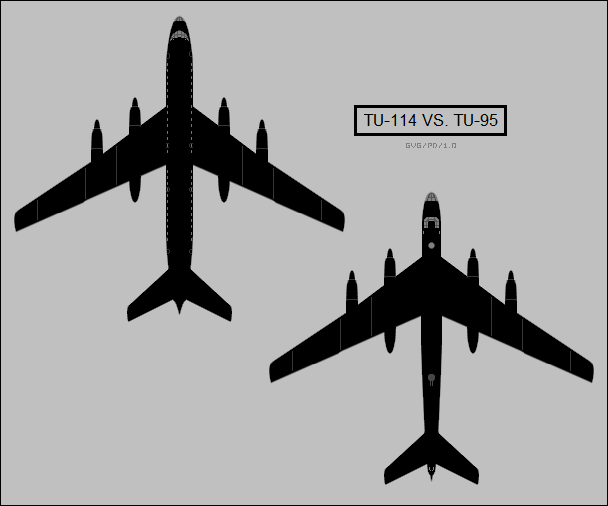
The Tu-114 used the wings and tail assembly of the Tu-95, coupled to a fatter passenger fuselage -- initial design concepts had envisioned an even fatter fuselage with twin decks, but that notion was dropped as too ambitious. The wing was mounted low, not mid-fuselage as on the Tu-95, and as mentioned the main landing gear was reinforced to handle higher weights. The nose glazing was retained to give the navigator a view, a feature common if not universal to postwar Soviet airliners.
___________________________________________________________________
TUPOLEV TU-114 "CLEAT":
___________________________________________________________________
wingspan:
51.1 meters (167 feet 8 inches)
wing area:
311.1 sq_meters (3,349 sq_feet)
length:
54.10 meters (177 feet 6 inches)
height:
15.5 meters (50 feet 10 inches)
empty weight:
91,000 kilograms (200,620 pounds)
MTO weight:
171,000 kilograms (376,990 pounds)
max cruise speed:
770 KPH (480 MPH / 415 KT)
service ceiling:
12,000 meters (39,400 feet)
range:
6,200 kilometers (3,850 MI / 3,350 NMI)
___________________________________________________________________
A modest total of 31 production machines was built to end of manufacture in 1964, some with a 170-seat arrangement and some with a 200-seat arrangement; the 170-seat machines were simply designated "Tu-114", while the 200-seat machines were designated "Tu-114-200". Most or all of the 170-seat machines were eventually updated to the 200-seat arrangement.
The Tu-114 was generally used on long internal domestic flights -- Moscow to Vladivostok, for example. It was also used to a lesser extent for international flights -- initially to Havana, later to Montreal and Tokyo. The flights to Tokyo were conducted as a collaboration with Japan Air Lines, featuring partly Japanese crews and JAL markings, along with the Aeroflot markings. Long-range machines for international service were typically updated with additional fuel tanks, giving more range at the expense of passenger capacity, these machines designated "Tu-114D" to indicate long range. The Tu-114 proved economical and reliable in service, being fitted with updated avionics in the course of its service. Airframe fatigue forced the permanent grounding of the fleet in 1976. At least one survives on static display.
There was thought of developing a military transport version of the Tu-114. The idea had come up during early development, the concept being designated "Tu-115", but it wasn't pursued. From 1963, a military transport variant designated the "Tu-114T" was investigated in turn, featuring such elements as a hinged tail assembly for loading large cargoes -- but development of the Antonov An-22 heavy cargolifter eliminated any need for the Tu-114T.
* While the Tupolev OKB was working on the Tu-114, the organization also was handed a directive to convert two production Tu-95 machines into long-range / high-speed VIP transports for senior Soviet officials, fitted for luxury and with accommodations for support staffs. Modifications to these two machines, which were designated "Tu-116", were completed in 1957, with initial flight in 1958. They were fairly comprehensive upgrades, with all combat kit deleted -- the tail turret position was neatly faired over -- and twin pressurized passenger compartments installed in the bomb bay position. Round airliner-type portholes were fitted along each side back from the wings. Passengers got in and out through a built-in loading stair built into the belly of the rear fuselage.
The Tu-116 was never actually used to carry high government officials; as it turned out, the Tu-114 was the better solution for that mission. The Tu-116s were used by the Red Air Force as transports for the senior officials of the service, however, and it seems two more Tu-95s were modified to the Tu-116 configuration. They were all finally grounded in the 1990s.
* The Tu-114 was used as the basis for the USSR's first airborne early warning (AEW) radar plane, the "Tu-126". Investigation of a Tu-114 fitted with the powerful Liana radar began in 1958, with formal commitment to development in 1960. Initial flight of the Tu-126 prototype was in early 1962, with introduction to service in 1965. NATO assigned the type the reporting name "Moss".
The Tu-126 airframe was much like that of the Tu-114, the visible external changes being fit of a "mushroom" radome on top of the rear fuselage, a fixed ventral fin to compensate for yaw instability created by the radome, deletion of passenger windows, and various bumps and antennas for other electronic kit such as communications gear and countermeasures -- there had been thought of fitting the machine with a tail turret, but passive defense was judged more realistic. Two crews were carried, with a rest and bunk area for the off-duty crew. While the prototype did not have an inflight refueling probe, the production machines did.
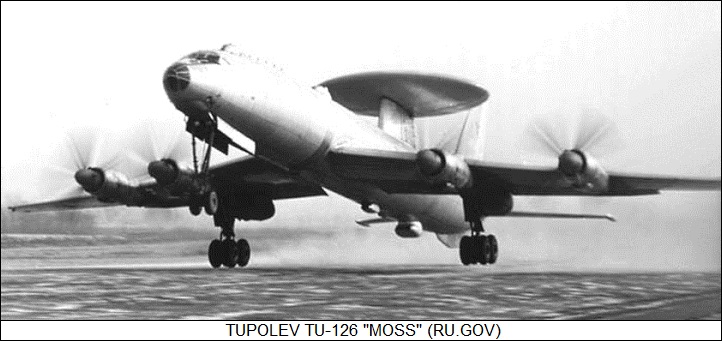
Only eight production machines were built; some sources claim they were conversions of Tu-114s, but that seems to be false. They gave fair service into the late 1960s, being given improved avionics kit over time -- but lacking "lookdown" capability to spot low-flying aircraft in "ground clutter", they were finally replaced by the more sophisticated Ilyushin A-50, an AEW derivative of the Il-76 jet cargolifter. Although the Tu-126 was never exported, the Soviets loaned one to India during the 1971 Indo-Pakistan War, the aircraft being operated by a Soviet crew with Indian liaison staff on board.
There was some thought of developing a turbojet-powered version of the Tu-126, the "Tu-156", but it never got beyond the scale model stage. Incidentally, following up work towards a nuclear-powered Tu-95 in the late 1950s and early 1960s, work was also performed in the early 1970s on a nuclear-powered maritime patrol aircraft based on the Tu-114, the "Tu-114PLO". Once again, the concept was ultimately judged impractical and the effort abandoned.
BACK_TO_TOP* The following list gives primary Bear variants:
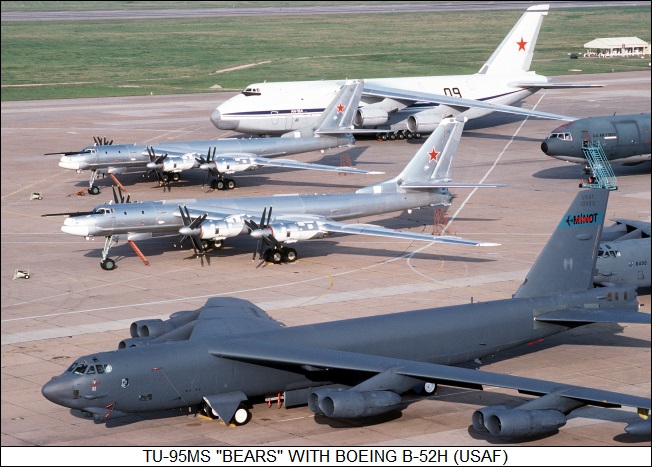
* Sources include:
* Revision history:
v1.0.0 / 01 jun 11 v1.0.1 / 01 apr 13 / Review & polish. v1.0.2 / 01 mar 15 / Review & polish. v1.0.3 / 01 feb 17 / Review & polish. v1.0.4 / 01 jan 19 / Review, update, & polish. v1.0.5 / 01 dec 20 / Review, update, & polish. v1.0.6 / 01 oct 22 / Review & polish. v1.0.7 / 01 jul 24 / Review & polish. (+)BACK_TO_TOP
